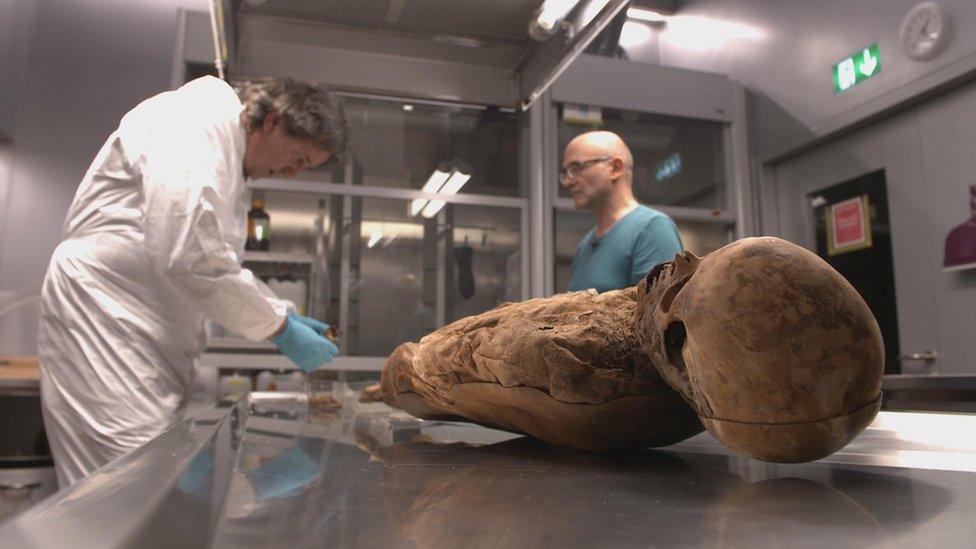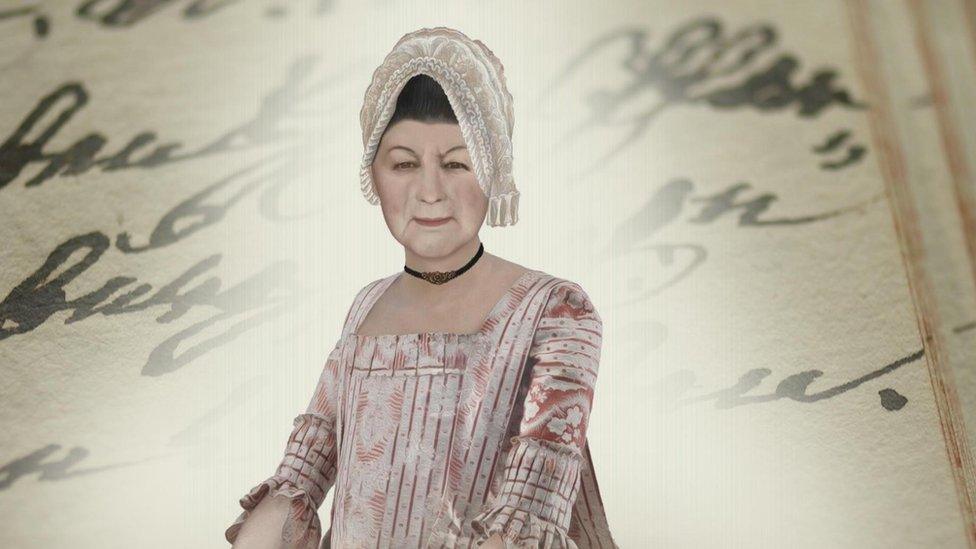Boris Johnson 'is descendant' of mummified Basel woman
- Published
Boris Johnson: Mummy is distant ancestor
Scientists in the Swiss city of Basel have solved a decades-old mystery over the identity of a mummified woman.
Their research revealed a surprise: the woman is the great-great-great-great-great-great-great grandmother of UK Foreign Secretary Boris Johnson.
The body was uncovered in 1975 while renovations were being done on Basel's Barfüsser Church.
She was buried right in front of the altar, clearly well fed, and wearing good quality clothes.
This was obviously the body of a wealthy lady of Basel.
But who was she exactly, and when did she die?
Mercury poisoning
There was no gravestone to indicate her identity, but initial testing of her wooden coffin suggested it dated from the 16th Century.
Another clue: her body was riddled with mercury - a standard treatment for syphilis from the late 15th to the 19th Century. Highly toxic mercury treatment was more often a kill than a cure and it was this that preserved her body.
But that still left open the question of who she was.
Basel in the 16th and 17th Centuries was a wealthy trading city; its port on the river Rhine was a key hub for moving goods across Europe, and it remains so today.
Local historians knew that members of Basel's wealthy families were buried in and around the Barfüsser Church.
For centuries, Barfüsser Church held clues to the ancestral history of Boris Johnson's family.
Some were clearly named in records, some had clearly marked gravestones.
But not the mummy. It only became clear in 2017, in newly discovered archives, that the mummy had been uncovered once before, in 1843.
Those records led historians to suspect the mummy was a member of a well-established Basel family, the Bischoffs.
DNA testing
Using the most up to date methods, scientists were able to extract DNA material from the mummy's big toe.

Scientists have used DNA testing to establish the mummy's identity
This was compared, by scientists working independently from one another, with DNA taking from living descendants of the Bischoff family.
The results were clear, showing a 99.8% probability that the descendants and the mummy were all from the same maternal line.
Now the scientists and the historians were sure: the mummy was none other than Anna Catharina Bischoff. Born in Basel in 1719, she died there in 1787.
Illustrious descendants
Once her identity had been established, genealogists were able - with the help of the efficient records of births, marriages, and deaths which tend to be kept by the wealthier classes - to trace more of Anna Catharina's descendants.

An artist's impression gives an idea of how researchers think Anna Catharina Bischoff might have looked
She had seven children. Only two survived childhood, but one daughter, also Anna, married a certain Christian Hubert Baron Pfeffel von Kriegelstein. Five generations of von Pfeffels later, and we find Marie Luise von Pfeffel marrying one Stanley Fred Williams.
Their daughter Yvonne married Osman Wilfred Johnson Kemal… and their son, Stanley Johnson, is British Foreign Secretary Boris Johnson's father.

You may also like:

Boris Johnson had already been aware of the von Pfeffel connections, having once told the BBC programme Who Do You Think You Are? that they were "posh toffs". He was clearly delighted by the discovery of his ancestor.
Allow X content?
This article contains content provided by X. We ask for your permission before anything is loaded, as they may be using cookies and other technologies. You may want to read X’s cookie policy, external and privacy policy, external before accepting. To view this content choose ‘accept and continue’.
After hearing of the find, Stanley Johnson told the BBC he thought it was "most brilliant" that scientists had managed to make the connection.
"I think she's rather nice," he said of his ancestor.
But what of Anna Catharina herself? Did she, to borrow a phrase from her seven-times great grandson, live a life of blameless domesticity?
In fact she seems to have.

Many of Anna Catharina Bischoff's descendants - including Stanley Johnson (right) and Rachel Johnson - are in the public eye
She married a church minister, and lived for much of her adult life in Strasbourg. There, it is believed, she may have contracted syphilis while caring for patients with the sexually transmitted disease.
On the death of her husband she returned to her home town of Basel, and apparently underwent rigorous mercury treatment in the hope of a cure.
It did not work: scientists believe Anna Catharina probably died from mercury poisoning.
But the mercury also preserved her body - allowing today's researchers to find out exactly who she was, and who her descendants are.
- Published14 July 2016

- Published14 November 2017

- Published8 December 2017